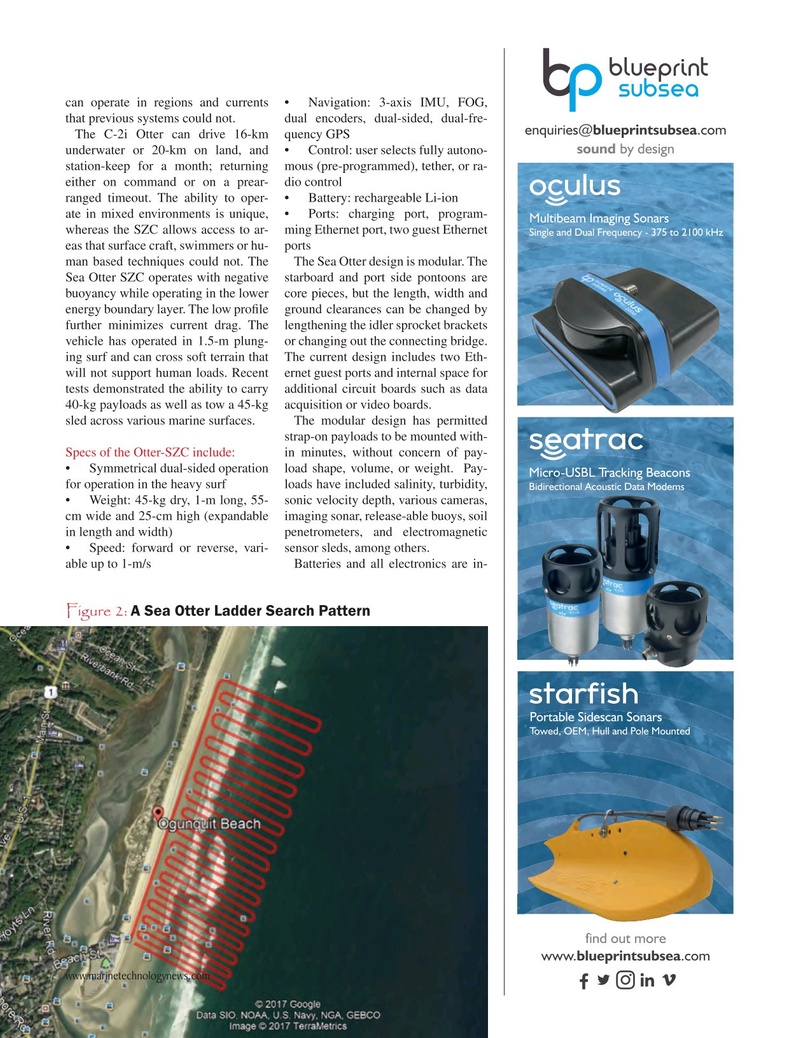
Page 31: of Marine Technology Magazine (September 2018)
Autonomous Vehicle Operations
Read this page in Pdf, Flash or Html5 edition of September 2018 Marine Technology Magazine
can operate in regions and currents • Navigation: 3-axis IMU, FOG, that previous systems could not. dual encoders, dual-sided, dual-fre-
HQTXLULHV#EOXHSULQWVXEVHDFRP
The C-2i Otter can drive 16-km quency GPS
VRXQGE\GHVLJQ underwater or 20-km on land, and • Control: user selects fully autono- station-keep for a month; returning mous (pre-programmed), tether, or ra- either on command or on a prear- dio control ranged timeout. The ability to oper- • Battery: rechargeable Li-ion ate in mixed environments is unique, • Ports: charging port, program- 0XOWLEHDP,PDJLQJ6RQDUV whereas the SZC allows access to ar- ming Ethernet port, two guest Ethernet 6LQJOHDQG'XDO)UHTXHQF\WRN+] eas that surface craft, swimmers or hu- ports man based techniques could not. The The Sea Otter design is modular. The
Sea Otter SZC operates with negative starboard and port side pontoons are buoyancy while operating in the lower core pieces, but the length, width and energy boundary layer. The low pro? le ground clearances can be changed by further minimizes current drag. The lengthening the idler sprocket brackets vehicle has operated in 1.5-m plung- or changing out the connecting bridge. ing surf and can cross soft terrain that The current design includes two Eth- will not support human loads. Recent ernet guest ports and internal space for tests demonstrated the ability to carry additional circuit boards such as data 40-kg payloads as well as tow a 45-kg acquisition or video boards.
sled across various marine surfaces. The modular design has permitted strap-on payloads to be mounted with-
Specs of the Otter-SZC include: in minutes, without concern of pay- • Symmetrical dual-sided operation load shape, volume, or weight. Pay- 0LFUR86%/7UDFNLQJ%HDFRQV for operation in the heavy surf loads have included salinity, turbidity, %LGLUHFWLRQDO$FRXVWLF'DWD0RGHPV • Weight: 45-kg dry, 1-m long, 55- sonic velocity depth, various cameras, cm wide and 25-cm high (expandable imaging sonar, release-able buoys, soil in length and width) penetrometers, and electromagnetic • Speed: forward or reverse, vari- sensor sleds, among others.
able up to 1-m/s Batteries and all electronics are in-
Figure 2: A Sea Otter Ladder Search Pattern 3RUWDEOH6LGHVFDQ6RQDUV 7RZHG2(0+XOODQG3ROH0RXQWHG
ILQGRXWPRUH
ZZZEOXHSULQWVXEVHDFRP www.marinetechnologynews.com
MTR #7 (18-33).indd 31 MTR #7 (18-33).indd 31 9/6/2018 10:47:04 AM9/6/2018 10:47:04 AM

 30
30

 32
32
